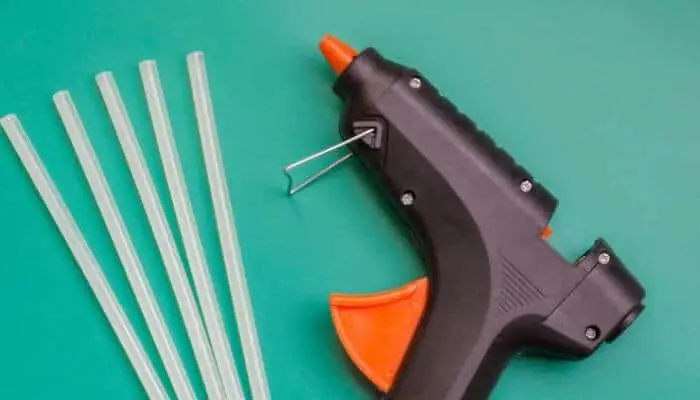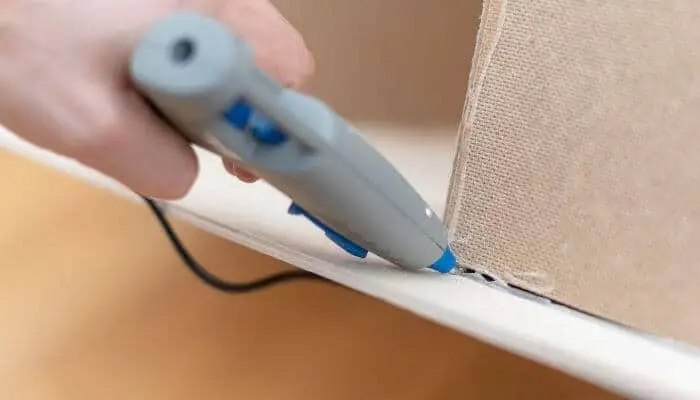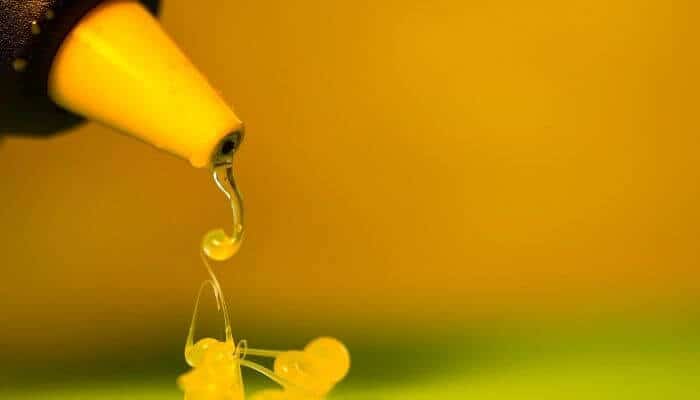Hot glue is typically very waterproof and water-resistant.
It handles water and most solvents very well, and can withstand hot and cold temperatures, as well as various types of weathering, eroding, and chemicals.
It doesn’t make a good sealant formula, even if it is very water-resistant, but it does create a very waterproof bond between two objects.
This means that if you had two porous slabs, and you stuck them together with a fine film of hot glue, the water would penetrate one, but never reach the other.
This is obviously an extreme example, but even if you were to drop a ball of the glue into seawater, it would withstand the saltwater, chemicals, and even the sea’s abrasive weathering very well.
What is Hot Glue?
Also known as hot melt adhesive, hot glue is a thermoplastic adhesive. Its most common form is as “sticks” designed to be used with a hot glue gun.
The gun has an element to heat the stick to liquid form which is then applied using the nozzle.

When hot (at a temperature sufficient to burn skin), the glue is sticky and will dry/solidify within a few seconds up to a minute.
Glue guns are readily available and are popular with crafters and DIYers but hot glue also has industrial uses.
Can Hot Glue Be Used as a Sealant?
If hot glue is waterproof and can withstand various types of weathering, does that make it a good sealant?
There are many factors to consider, but in most cases, no it does not.
The biggest reason it doesn’t make a good sealant is that it is not very workable once it is applied.
Many other types of sealant can be adjusted, worked, moved and even spread to accommodate its need.
However, once hot glue is out, you have a few seconds to adjust it, but the more you work it, the less effective it becomes.

If you were to seal an area very well, in that you applied the sealant very well, then it would hold off many types of water and chemicals, which includes long-time exposure to solvents.
However, you have to remember that while the sealant itself may not be affected, the materials it is stuck to may be.
If the seal created by the glue starts to weather or come away, then water and humid air will leak through.
Another factor that makes hot glue a less-than-ideal sealant is that it doesn’t have as much flexibility once it is applied.
Many times, sealants have to move and flex a little so that they do not create cracks.
Hot glue may set in a way that makes it very inflexible, which means it will pull away from other components or it will crack.
Putting Pressure on the Glue
As a glue, it does handle pressure very well. It may not be flexible, but it is an excellent adhesive and works in a way that enables you to put weight on the stuck-together items.
For example, if you were to glue two pieces of wood together, and then put an anvil on the planks to compress them, the glue would still work and still keep the planks stuck together afterward.
However, if you put a sealant between the planks, allow it to set/cure, and then put an anvil on it, the sealant would disintegrate, and the planks would become unstuck.
Also Read:
A Polymer Plastic
Hot glue is a variety of polymer plastic that is flexible and malleable when warmed but exists in a solid state when it has cooled.
The interwoven polymer structure is dense enough that it doesn’t allow water molecules to pass through.
The polymeric strands in all purchasable hot glue are arranged in a way that makes hot glue impermeable for water and most types of fluid.
The problem for some is if this waterproof mixture will withstand being submerged underwater for extended periods.
In truth, the glue itself will remain pretty unchanged even if you keep it underwater for many years.
However, the bonds between the glue and whatever it is sticking together may come apart much more quickly.

For example, if you are trying to glue together your plastic submarine in a way that keeps out the water, then it will do a pretty good job.
On the other hand, if you are gluing together your large 80-ton submarine, then things may come unstuck.
The point is that the effectiveness of the glue on the surfaces you are sticking is what matters when you are planning to submerge something underwater for extended periods.
Gluing something underwater with a hot-glue gun is just silly.
Gluing something you wish to keep underwater is not as silly.
However, you will need to buy a hot glue that is fit for purpose.
For example, if you are gluing part of your pond pump together, then not all hot glues are built equal.
Some are going to be more suitable and last longer than others, especially if the pump is going to exert pressure on the part being glued.
Should You Use Hot Glue Outside?
It all depends on the application.
For example, if you are gluing the plastic part of your yard lamp onto the plastic casing, then a hot glue that isn’t affected by UV light will do well.
Polyethylene-based (PE, PEMA, PEnBA) hot glues do not suffer from UV degradation in any significant way, so using one of those would be fine.
However, if you were sticking plastic tassels to a BMX bike that you wish to ride in the open air, then hot glue probably wouldn’t be a good option.
Again, it is all about the materials you are sticking together.
For example, sticking together two pieces of wood to be used indoors is a great idea, and waterproof seals will be formed.
However, that same wooden object would suffer outside because of how the water permeates the wood and makes it expand, and because of how the wood will shrink and expand due to the weather, making the glue less effective and less waterproof.
In short, hot glue is very waterproof and in some cases is UV-light proof too. It is an ideal glue, but only in certain circumstances.
As mentioned in this article, sometimes the glue is perfect for the application at hand, and for some materials, conditions and circumstances, hot glue is not recommended.
However, from the standpoint of glue properties, it is water-resistant and waterproof in its natural state, and that even includes when hot glue is applied upon hot glue that has cooled into a solid.
